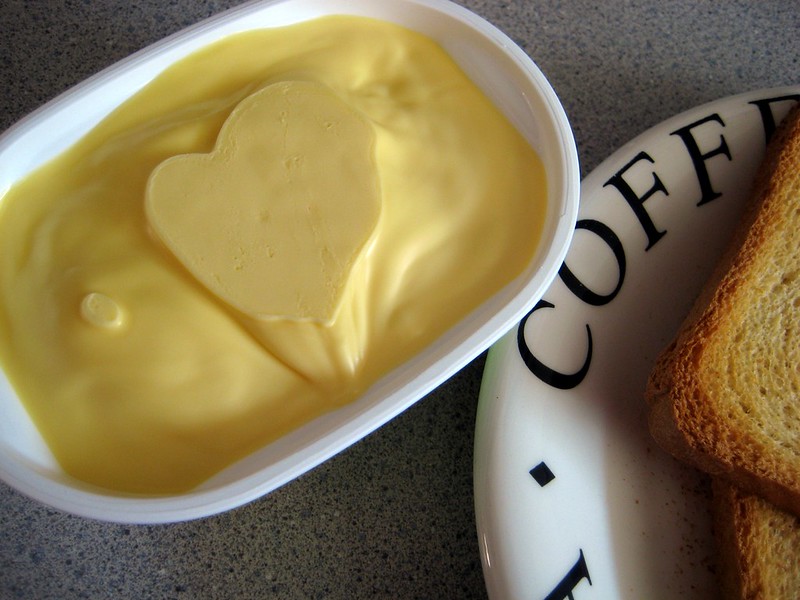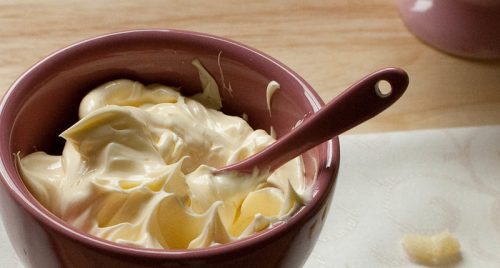Butter In Coffee – Recipe and Surprising Health Benefits

Coffee and butter may not seem an obvious choice to pair each other with. After all, coffee is straight, strong, and mostly calorie-free. Butter on the other side is heavy, creamy, and with plenty of calories.
They don’t seem like a match made in heaven at first sight, but lots of people have been adding butter to coffee for decades, if not for centuries, and swear by it. In Ethiopia, the land where coffee was born, they used clarified butter as an addition to ground coffee already in the ninth century.
In Asian countries like Tibet, North India, Vietnam and Singapore variations of butter coffee or tea have been popular for over a century now.
So butter in coffee is far from being a total novelty. It has reached new heights of popularity in recent years, when the CEO of Bulletproof, Dave Asprey, came back from Tibet where he was served black tea with butter. That sparked the idea of introducing butter coffee to the USA. From then, the trend sparked lots of interest and imitators.
Thus, nothing new or weird. Indeed, if we stop to think more carefully, it is not such a strange combination. Cream has been a staple of many cafes, added on top of coffee for centuries. And cream, like butter, is heavy, a dairy product, and has quite a few calories.
Nobody finds it weird, so butter shouldn’t be either. Cream and butter being similar in taste and texture, it is only natural that both can be added to coffee.
Perhaps more importantly is the why.
Why would you add butter to coffee? What would be the benefits, taste and health-wise?
Let’s see then first why would you choose to add some butter to your next cup of coffee.
Why Add Butter To Coffee
Taste, mostly. As with anything related to coffee, if you like the taste, why not? Butter obviously can provide a level of density and smooth texture that simple milk, or any of the milk derivatives, cannot. It is much heavier in the mouth than cream, less foamy though, and can donate a dense feeling to the coffee. This is something that the more liquid milk cannot do without being frothed or steamed.
Thus, butter in coffee can be a way to have a coffee that is denser, heavier, and feels creamy without having to deal with the steaming and frothing of milk and cream.

Convenience then is another factor that pairs with taste. It is extremely easy to just pop a scoop of butter on a freshly brewed coffee, wait for it to melt, and enjoy your butter coffee cup. There’s barely any skill involved, making butter coffee accessible to newbies of the coffee-making world.
Unlike some of the more complex coffee recipes, butter coffee doesn’t require an espresso to be made. You can use your favorite coffee brewer, like an Aeropress or French Press, and a simple blender. The necessary equipment to make a butter coffee is therefore minimal and accessible to anyone.
The why is then more of a “why not?”. With these minimal requirements and skills needed to make a good butter coffee, there’s really no reason to not try to make it at least once. At least just to see if you like it.
Using Coconut Oil
As with anything containing lactose and being of animals origins, there’s an alternative to using butter in coffee as well. Coconut oil can be easily added instead of classic butter for vegans or lactose-intolerant coffee drinkers. Coconut oil is another fatty ingredient that merges with coffee even quicker than normal butter.
The consistency and taste will be different. Coconut oil is less dense, with a minor feeling of “cream” than the milk-derived butter. On the upside, coconut oil is easier to blend and covers less the taste of the coffee compared to butter. The texture of the coffee will be quite unlike proper butter, but many prefer it.
Health benefits of coconut oil vs butter are long being debated. Both contain a good deal of calories, pack a bunch of saturated fats along with more digestible medium-chain fatty acids (MCT).
While the latter helps you by giving you a sense of satiety and being quick to assimilate by the body, the former isn’t exactly a boon for the heart and blood circulation. The many calories contained in both butter and coconut oil can derail many diets.
Do make your evaluation between butter or coconut oil based on which is better for your diet and needs.
In any case, coconut oil vs butter is not a one or the other confrontation. Many add both, hopefully getting the best of both worlds. Custom butter coffee recipes call for both sources of fats to use in a proper butter coffee so it does not have to be a definite choice.
Butter Coffee vs Bulletproof Coffee
The term “bulletproof coffee” has been surely heard by many of you readers. Is butter coffee the same as bulletproof coffee? Not quite.
To start, Bulletproof is a brand, created by the same Dave Asprey that imported the idea of adding butter to coffee in the USA from Tibet. While butter coffee then is just a recipe, made of butter and/or coconut oil with coffee, blended together, bulletproof coffee is more than that.
It is a specific way to make a butter coffee using only unsalted, grass-fed butter, and includes a liquid called MCT oil. These are the same fatty acids contained in coconut oil but synthetically extracted to create this medium-chain triglycerides substance.

It is used in bulletproof coffee as an immediate source of energy that is supposed to enhance your metabolism and be very rapid to digest.
Bulletproof coffee is meant to be ingested within a specific diet, devised by the company behind the coffee recipe. It is a plan for weight loss without losing energies, and a balanced diet at that. Bulletproof coffee is more than butter coffee, more specifically made, and thought to be part of a larger diet and lifestyle.
Butter coffee is simply a recipe, and quite an old one at that. It has many variants, but it remains just that, a recipe to enjoy coffee. Its health benefits are only complementary to the recipe, and not central to the idea, as with bulletproof coffee.
And speaking of recipes, let’s jump into how to make a classic butter coffee.
Butter Coffee Recipe
For a classic butter coffee you need only three ingredients: unsalted butter, coconut oil and your coffee of choice. Then you need a brewing system to make coffee. And as we have seen truly any will do. Plus a blender, to blend it all together.
The steps to make butter coffee are straightforward. Brew your coffee any way you want, add a pat of butter and a scoop of coconut oil to it. Pour everything into a blender and blend for around 30 seconds. Pour into a serving cup and enjoy.
This is the basic recipe. From there, as with most coffee drinks, you can customize and perfect it to your tastes. You can make butter coffee versions of classic coffee recipes. For instance, sprinkle some cocoa powder on top to make it a mocha coffee. Add peppermint extract for a peppermint mocha.
A butter coffee latte can be done with a splash of vanilla extract and/or some milk. A scoop of whipped cream can make the butter coffee into a viennese butter coffee.
You get the idea.
Combine one or two ingredients of another coffee drink into the basic butter coffee recipe to make a variant with butter in it.
Cons Of Butter Coffee
The more health-conscious among you may have already thought of a few cons of butter coffee.
As butter coffee, along with its more famous cousin bulletproof coffee, is advertised as a breakfast alternative for satiating and keeping you on the right diet, some shortcomings of this choice immediately come to mind.
First, butter coffee has nowhere close to the number of healthy nutrients like proteins, vitamins, and minerals as a proper breakfast. Make sure the other meals of the day can provide those as butter coffee alone will not.
Calories are far above a normal coffee, even with milk. Coffee alone has around 2 calories, but coconut oil and butter can stack up to 200-250 calories on their own. If you are not drinking butter coffee only in the morning, be aware of this amount and if it fits your daily calorie target.
The high amount of fats in butter coffee can cause stomach discomfort to some. Bloating and diarrhea are not to be underestimated for some individuals that have a low tolerance for fatty acids.
The quantity of cholesterol in butter coffee is cause for concern. Dietary cholesterol doesn’t affect everybody the same but for some, cholesterol hyper-responders, butter coffee can seriously spike the cholesterol levels in blood.
As with anything related to diet, keeping the right balance is the key. Consult your doctor before your start consuming butter coffee as your regular coffee in the morning. Especially if you are not supposed to have a high-fats diet.
Final Words
Butter coffee, and its commercial version bulletproof, is a craze nowadays, and for many good reasons. It is tasty, donates to coffee a texture that milk alone cannot, and is a nice and satiating coffee drink for a hearty and warming morning. Athletes have discovered its benefits in giving a great deal of calories plus caffeine, without charging them with sugars, like milk-based coffee drinks would.
Easy to make, easy to enjoy, it has common ingredients and a low price. Just be aware of its cons health-wise and check with your doctor before integrating it into your diet. If your health allows it, butter coffee is surely worth a try. It is so easy to make that it would be a pity to renounce having one, even only occasionally.
